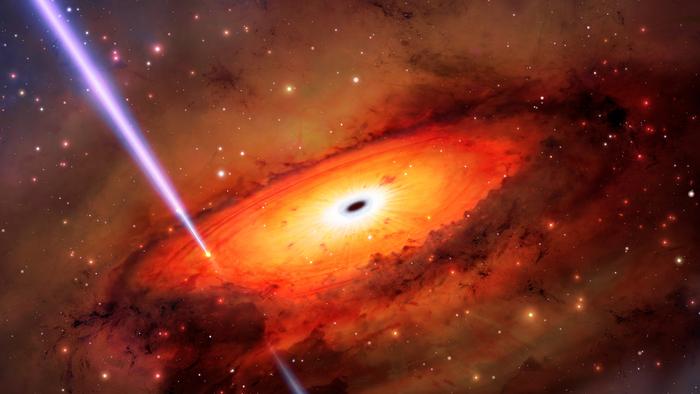Yet a new paper shows there may be a fourth way - a collision where non-binary stars in dense regions can be forced together. The work used a long-duration gamma-ray burst with the Gemini South telescope in Chile.
Ancient galaxies are long past their star-forming prime and would have few, if any, remaining giant stars, the principal source of long GRBs. Their cores, however, are teeming with stars and a menagerie of ultra-dense stellar remnants, such as white dwarf stars, neutron stars, and black holes. Astronomers have long suspected that in the turbulent beehive of activity surrounding a supermassive black hole, it would only be a matter of time until two stellar objects collide to produce a GRB. Evidence for that type of merger, however, has been elusive.

Artistic representation of a gamma ray burst. Credit: International Gemini Observatory/NOIRLab/NSF/AURA/M. Garlick/M. Zamani
The first hints that such an event had occurred were seen on 19 October 2019 when NASA’s Neil Gehrels Swift Observatory detected a bright flash of gamma rays that lasted for a little more than one minute. Any GRB lasting more than two seconds is considered “long.” Such bursts typically come from the supernova death of stars at least 10 times the mass of our Sun — but not always.
The researchers then used Gemini South to make long-term observations of the GRB’s fading afterglow to learn more about its origins. The observations allowed the astronomers to pinpoint the location of the GRB to a region less than 100 light-years from the nucleus of an ancient galaxy, which placed it very near the galaxy’s supermassive black hole. The researchers also found no evidence of a corresponding supernova, which would leave its imprint on the light studied by Gemini South.
In normal galactic environments, the production of long GRBs from colliding stellar remnants such as neutron stars and black holes is thought to be vanishingly rare. The cores of ancient galaxies, however, are anything but normal and there may be a million or more stars crammed into a region just a few light-years across. Such extreme population density may be great enough that occasional stellar collisions can occur, especially under the titanic gravitational influence of a supermassive black hole, which would perturb the motions of stars and send them careening in random directions. Eventually, these wayward stars would intersect and merge, triggering a titanic explosion that could be observed from vast cosmic distances.
It is possible that such events occur routinely in similarly crowded regions across the Universe but have gone unnoticed until this point. A possible reason for their obscurity is that galactic centers are brimming with dust and gas, which could obscure both the initial flash of the GRB and the resulting afterglow. This particular GRB, identified as GRB 191019A, may be a rare exception, allowing astronomers to detect the burst and study its after effects.






Comments